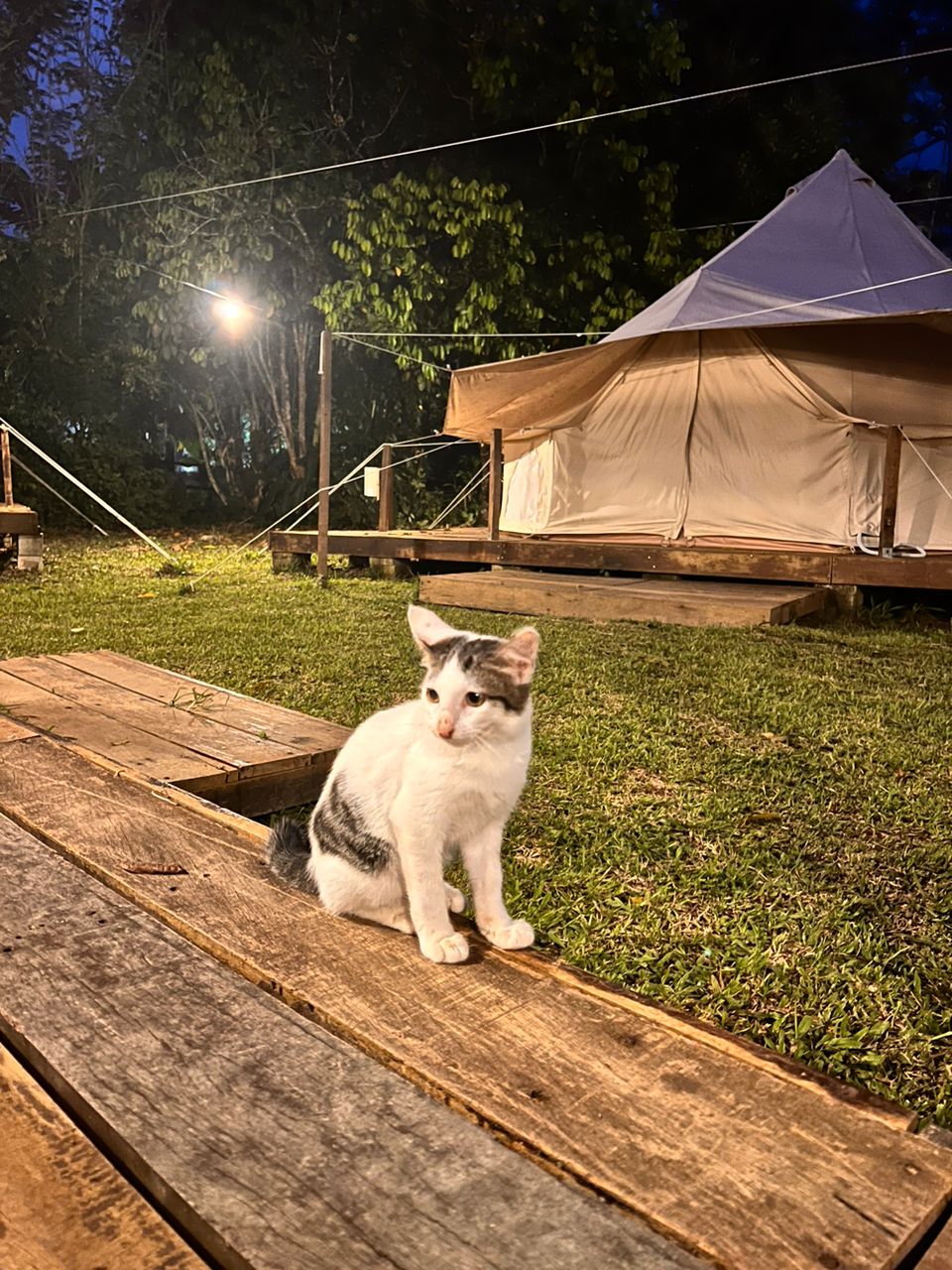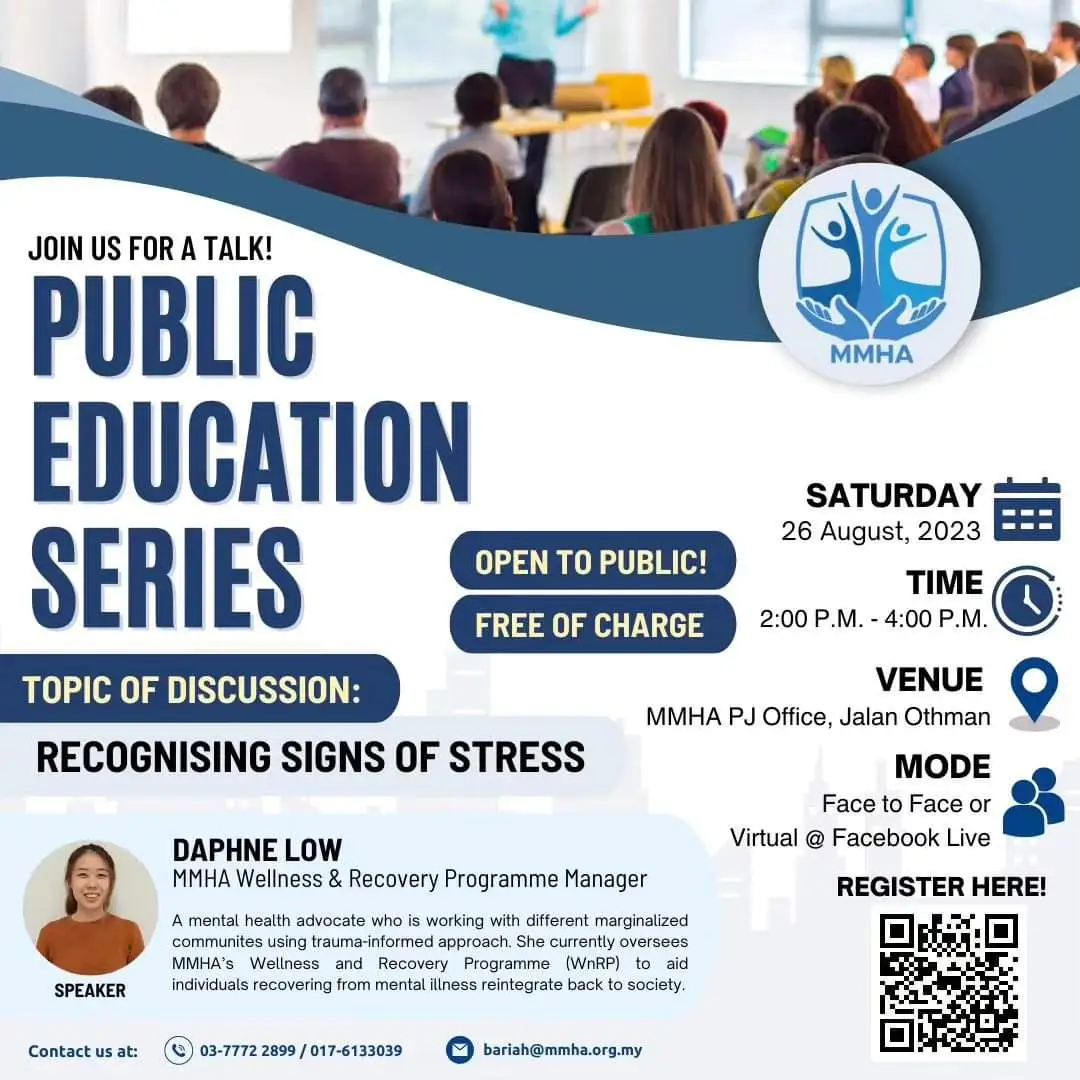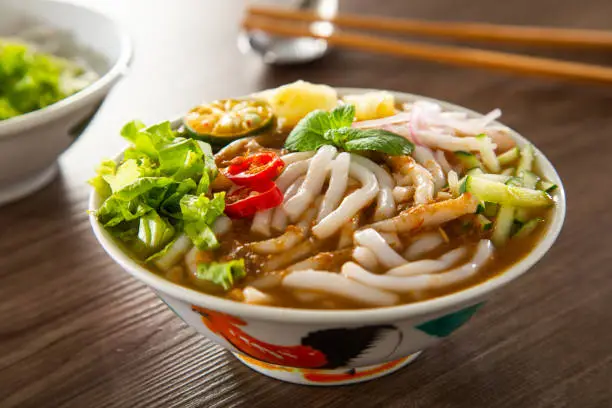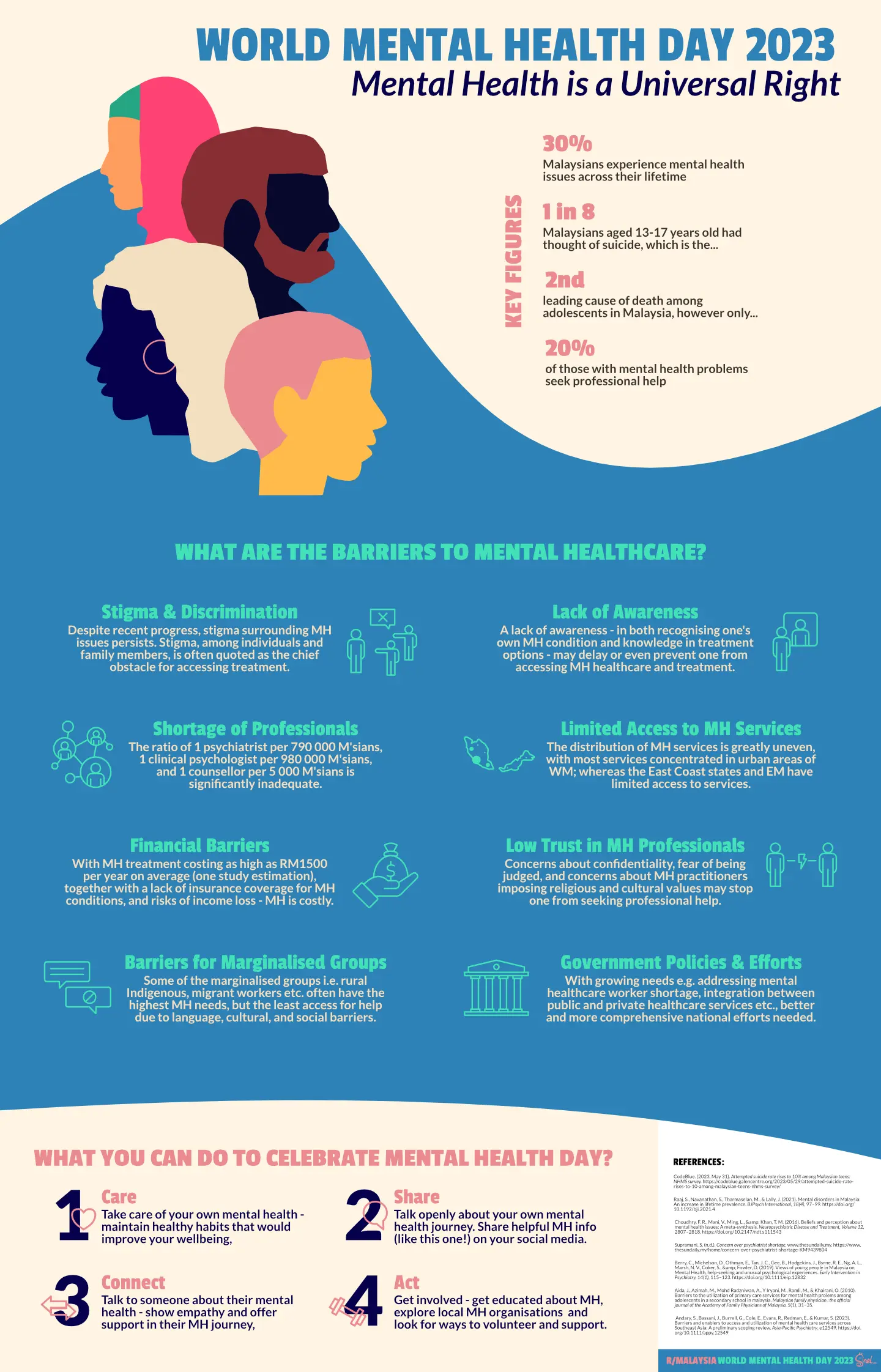Just finished No Easy Day by Mark Owens, the autobiography of a Navy Seal who took part in the operation to hunt down and kill bin Laden. Interesting to read about the account if nothing else.
Also just realised this is my fourth consecutive book about war. Going to do something different next. Maybe some recommendations?
"The Things They Carried" by TIm O'Brien. Usually I prefer less of fiction, but it's less of a narrative story of 'what happens next' or 'what is happening' but more of what is happening inside the minds and hearts of the characters, which is something I really like. Favourite story so far is "Speaking of Courage" which tells all the internal conflicts and struggles of someone coming back from war - real powerful and emotional read.
Community Mental Wellness Fair


Description from Organisers:
Co-organised by Taylor’s Centre for Counselling Services, Impact Lab 8 Mental Health & Wellbeing and Life Inspired Network Society, LINetS (an NGO which champions suicide prevention through media, education and counselling) this event coincides with World Suicide Prevention Day (10 Sept) and World Mental Health Day (10 Oct).
The highlight of this fair is the booth exhibition featuring a comprehensive range of counseling services and mental health awareness by various NGOs, private counseling organizations and governmental organizations, all under one roof. There will also be concurrent mental health related workshops, debate competitions and other fun activities throughout the day. Communities of all ages are welcome.
Workshop Information:
Workshop 1 - Discovering Your True Self: Awareness & Acceptance
Workshop 2 - Strengthening Connections: Building Communities & Meaningful Relationship
Workshop 3 - How Can I Prevent Suicide Among People I Know?
Note: A nominal registration fee of RM10 is applicable for each workshop session.
Registration for the Mental Wellness Fair can be done via this Google Form.

Went out and got this because of your post, ha!
Trying the lemongrass and pandan tea, it's quite delightful indeed. The taste does remind me of certain nyonya dish because of it's strong serai and pandan taste though!
The Christians and early missionaries had indeed played a major role in public education in Malaysia, and some of the most prestigious public schools today were set up or in one way or another linked to the early Christians' works in the country. So putting religion aside, even just for sentimental reasons, it is actually quite a sad thing to see the decline or closure of mission schools today.
But fairly, this is not, or not only, at least, a fault of the government and the authorities. The past and current Christian counterparts would have to bear an equal responsibility in this decline. What people might not know is, the Church (in this case which I am personally informed, the Methodist Church in Malaysia - can't comment on other Christian denominations) does actually have a voice within the Federal Government in the matter of the public mission schools linked to the Methodist Church, e.g. MBS/MGS, ACS. And for many years, even in the days of previous leaders, the Church was given the right to nominate their own candidates for the role of the Principal in the schools. But few Christians would take up the responsibility, hence leaving the mission schools at the government's mercy in appointing whoever they want to the leadership positions - and as a result, the "Christian" identity (and influence) of the schools diminishes fast. And today, the Methodist Church is dipping their toe in private education institutes themselves and it'll be no surprise if the effort to hold on to the public schools is even lower of a priority for the Church.
And in certain Christian circles, due to one factor or another, fewer and fewer parents are inclined to send their child to public schools (missionary schools or otherwise), which while completely understandble and justified, it is for me personally quite a sad thing to see - that as Christian ourselves are not as concerned with asserting our positive influence and with contributing to the community than our forefathers were.
Perhaps a more exciting news to the professional community than to the general public, ha. But how it turns out will certainly have a direct impact on the general public, hopefully significantly positive ones in terms of better accessibility and quality of MH services.
What I'm personally interested and looking forward in particular is the emphasis on coordination and collaboration between the public and private + civil/community sector. Was very supportive of this when first raised by KJ in the previous government - hopefully this is a continuation of this initiative.
Professionally, I'm hoping for clearer and wider recognition of the counselling and psychotherapy services (non-medical) by the public health authority. Specifically, for one, for MOH to recognise referrals by licensed counsellors and clinical psychotherapists. (Right now the government hospitals only recognise referrals by medical practitioners/GPs for someone to receive treatment by specialists/psychiatrists. But in reality, counsellors and psychologists do in fact receive proper and adequate training in detecting and assessing clinical mental health conditions, and would be more than qualified to make professional judgement in making referrals for one to receive specialist/medical treatments).
Coversely, to encourage and provide a clear guidelines for psychiatrists to refer patients for psychotherapy services - especially in closer collaboration between the public and private/civil sectors. For one, psychiatrists rarely refer patients out to counsellors and psychologists to receive psychotherapy, together with or in lieu of medical treatment. But almost all mental health patients would benefit from some form of non-medical mental help, which ends up with the psychiatrists having to take up the responsibility of providing psychosocial support for the patients - which is not ideal. While I have no doubt a psychiatrist would be able to perform some rudiment form of therapy, their professional training is just not in such, compared with a counsellor or clinical psychotherapist whose core professional training is in psychotherapy, and hence a psychiatrist is not expected to be competent in handling the psychotherapy aspect of mental health treatment. Secondly, with an unbalanced ratio of psychiatrist to psychotherapist in the public healthcare service (not enough of clinical psychologists and counsellors in most healthcare facilities), most patients would miss out on the opportunity to receive a more comprehensive mental healthcare. So the aspect of collaboration is quite essential in the government's initiative - and something I'm mostly looking forward to.
Prime Minister Anwar Ibrahim told the Dewan Rakyat that the government is committed to improving healthcare services.

Key points:
- Putrajaya will establish a dedicated institution to deal with mental health issues affecting the rakyat.
- The move was to strengthen efforts to address the problem by coordinating the efforts of government, private sector and civil society organisations.
- Addressing the incease in mental health issues is a top priority for the government.
Finished Quiet by Susan Cain, finally - shared this as my read here some time ago. As a textbook introvert it wasn't exactly an easy read, emotionally, for me - so often had to put the book down to deal with all the emotions, to process the catharsis or to grieve for what past-me had to go through. But ultimately it was quite a positive read, though I wouldn't say that I agree with everything in the book - especially speaking from a professional perspective, personally I did find a lot of affirmation and validation from the book. I mean, just this morning I declined an invitation to a dinner party with just a slight hint of guilt, haha!
Reading something of an entirely different feel currently - had to go for something 'light' after the previous read. The Man Who was Saturday, a biography of Airey Neave.
Haha, this one even has hot shower! Which is greatly appreciated, because it rained quite a bit when we're there and it was super cold at night. But with all the luxuries it does take away a little of the"outdoor-y" feel so. 😆
We went to this site called Canopy Villa at Janda Baik. The place is actually very nice! The facilities are quite proper, and the tents and beds are considerably clean. And because it was Merdeka, the site put up a camp fire for us (for free; normally would have to pay for it). Quite a nice place for a short getaway.
Went glamping with the church group during the Merdeka holiday, it was lovely!

Though I'm physically exhausted (we stayed up until 4 for board games haha) and more so have depleted my social quota by the end of the trip, it was a really nice experience!
Ah gotcha. Good to know it's just a glitch with the site (can see the other comment though). Happy for your friend too!
Ay you ok? Or it's just something wrong with my app - couldn't see your comment (just seeing a comment from you but without text).
Mental Health Talk - Recognising the Signs of Stress


Text from event page:
What is stress? Learn more about it, and particularly its causes and how to recognise in yourself and others. It plays a crucial role in raising awareness, promoting understanding, and providing essential information to individuals and communities.
Join us and Ms Daphne Low, MMHA Wellness & Recovery Programme Manager, in our Public Education Series on Recognising Signs of Stress.
Together, let's increase awareness, provide support, and build resilience.
🗓️ Date: 26th August 2023 (Saturday) ⏰ Time: 2:00 p.m. - 4:00 p.m. 📍 Venue: MMHA PJ Office, Jalan Othman 🌐 Mode: Face-to-face or Virtual @ MMHA's Facebook Live
This event is open to the public. It's time to break the silence around mental health and start talking about it openly. Your presence matters!
Register now on this link https://forms.gle/AdsQouCVSYdvxsYn8 or scan the QR code on the image to secure your spot. Don’t miss out on this opportunity. We hope to see you there!
Happy to hear that!
For my former classmate's case it's less about academic results - we're from a quite a reputable high school after all - but more on that they were not the best behaving student in class. Though nothing bad and more of middle-schooler antics, but I remember them as quite a mischievous person, loud, and always ready for a prank. But I guess that was a way of them showcasing their leadership quality even back then.
But still it's indeed a good encouragement for young people to not base their self-value on results, also to be less anxious about their future directions, but that they'll also find their strengths and passion one day.
One of the little joys of going back home to vote - it's like a mini reunion, ha!
Also just discovered one of my former classmates was standing for election. Won by a large margin too. Never expected that, wasn't the best student in school, ha! But really glad for them, looking up some news and they seemed to be doing quite some work in their area.
Hey, some good news! Doulos Hope will be extending their stay in Penang for another 2 weeks, and the booking has just opened, so should have quite some slots still.
Yeah unfortunately the slots are extremely limited this time, apparently the only allow 200 visitors per hour slot so I have many friends who also failed to get a pass. Didn't get to visit them myself. I have some friends who signed up as volunteers though so did hear them sharing about the experience.
Imo they did suffer a bit from some bad planning and communication. They were planning to visit Penang much earlier but was delayed, while the delay was not their fault the subsequent communications were not really done well, many people were unaware of their latest schedule and by the time we got to know about their visit most of the slots were already been taken up by those who got the news earlier. Quite unfair like this la haha.
Sorry that you didn't get to visit them this time. Maybe next time (hopefully with better management haha!)
Glad you enjoyed the story and learned something interesting!
Thanks! Yeah it's so interesting isn't it? I love these kind of stories too haha. I first heard about the story from a friend, but did went on to look for more information and compiled the information I could find, and came up with this post.
Haha, hey!!! X2
But the taste is not actually the same or even similar. But the main ingredients and way of preparing have a lot of similarities, hence the inferred influence.
Do you know that Penang Asam Laksa is believed to be influenced by a traditional Burmese dish called Mohinga?


Do you know that Penang Asam Laksa is believed to be influenced by a traditional Burmese dish called Mohinga?
A SHORT HISTORY OF THE BURMESE HERITAGE IN PENANG
Penang has always been a cosmopolitan city - blessed by its strategic geographical location - even before the founding of the modern Penang by Francis Light in 1786, the ‘Pearl of the Orient’ has attracted people from neighbouring regions and faraway lands to gather in this beautiful land. Some stopped for a short stay, many settled down and called it their home - but all brought their own unique culture and story to make Penang a colourful and complex place as it is today.
However, comparing to the stories of the Europeans and Eurasians, the Chinese, the Indians, the Siamese, and others, the story of the Burmese in Penang is one that is less spoken about and shared, despite signs a notable presence back in their days.
The Burmese Connection
Connection between Burma (Myanmar as it is called then) and the Malayan peninsular began as early as the fifteenth century, if not earlier, with people from both regions migrating around and between the land for various reasons. But with the rise of the global East-West trade, with several coastal towns, such as Rangoon in the Lower Burma region and Penang turning into important sea ports along the trade route, the moving of goods, and people, between these two regions accelerated greatly, and reaching its peak in the 1800s as both regions came under the British rule.
The records of the earliest arrivals were vague, but by then, there was already a sizeable Burmese population in Penang. They were mostly centred in the Burmese Village in Pulau Tikus, with smaller settlements in Teluk Bahang and Batu Maung.
Dr MacKinnon's Residence, near Burmah Village | 100pfs
The earliest Burmese settlers were most likely fishermen, but soon there were also traders, merchants, labourers, and workers in factories - some of which were set up by wealthy Burmese businessmen who reside in Penang.
Taking Root
Among the most prominent was probably Sin Yew Kyong and his cheroot (cigar) factory. Son of a Burmese merchant of Chinese origin, he migrated to Penang as a 16-year-old young man, and later establishing his own factory producing Burmese cheroot, at 8 Tavoy Road, in early twentieth century. Sin’s cheroot business grew - he would later open his own cigar store at 12 Perangin Lane - and he famously brought over hundreds of young ladies from his native Burma to Penang, to work in his factory. These young ladies soon began to be known as the ‘cheroot ladies’, who were said to be highly sought after by local lads as wives, and many of them settled down in Penang and other parts of Malaya. Indeed, many of the Malaysian Burmese today are the descendants of the cheroot ladies.
Conversely, young ladies from Penang, particularly of the Peranakan group, also known as ‘Nyonya’, were seen as highly desirable marriage candidates by the successful and wealthy among the Sino-Burmese, both locally and in Burma. This included the ‘Burmese Cheroot King’, as Sin was known, who had a Nyonya lady as wife. Some of the Penang Nyonyas were brought over to Burma and stayed, while some of the rich Burmese merchants who would frequently visit Penang during their business trips took the young ladies as wives and essentially had their “second home” here. One of which who did as such was Aw Boon Haw, of the Tiger Balm fame, who had a residence at Cantonment Road with his Penang wife/mistress. Incidentally, Aw’s principal wife, a Madam Tay, was also from Penang.
The Cheroot Ladies | Lost Footsteps
Today, there is a small group of Burmese Malays in Myanmar, known as the Pashu people. More specifically, Pashu is also referring to the particular group of Baba-Nyonya, the Peranakan Chinese people and their descendants who moved to Myanmar and stayed there.
The Legacy
The Penang today is left with ample evidence of this historical Burmese connection. The areas surrounding the Burmese settlement - also used to be known was Kampung Ava, said to be named after the Burmese city Ava (present day Inwa) - in Pulau Tikus provide us with the strongest hints of how significant the Burmese community was in its day. The road that runs through the village and connects it to the city centre was named Burmah Road (spelled with an ‘H’ to reflect the old British spelling), which name remains to this day and is one of the major and longest roads in Penang. Off this road is Rangoon Road - with Rangoon the old name for Yangon, the former capital of Myanmar. There are also Mandalay Road, Moulmein Road, and Tavoy Road, all named after major cities in Myanmar, as well as Irrawaddy Road, after the Irrawaddy Delta.
But perhaps the most famous and prominent heritage of all is the Dhammikarama Temple in Burmah Lane, Pulau Tikus. This Burmese temple, built on a land donated by a female Burmese devotee, dates back to 1803, signifying the presence of a sizeable Burmese community as early as then. It is also the oldest Buddhist temple in the state. Originally a humble and modest place of worship, with the growing Burmese community, the British government at that time granted them some land for expansion to the temple to be made. The temple became the heart of the local community, not just as a religious centre, but with a well within the temple ground offering water supply before there was piped water in the area, it was an important community and social centre, not only to the Burmese but possibly the wider population nearby too. With continual support from the Burmese people, and later, the Penang government, the temple grew into the magnificent monument we have today - and two centuries later, it still stands strong to remind us of the Burmese Heritage in Penang.
Dhammikarama Temple | Wikimedia
The story of the Burmese Heritage in Penang might not be the most widely shared, and not something we learn about in the history textbooks. Indeed I as a Penang Lang am not aware of this before looking up this story, and we’re not left with a lot of reliable historical records. But it is no less interesting and significant - and the heritage is definitely as worthy to be preserved and the story to be told.
Doulos Hope - Floating Bookfair (Penang, EM)


Doulos Hope is a floating bookfair/library which mission is to promote literacy and education, and share knowledge and hope around the world. There are over 2000 book titles on board, and visitors have a chance to interact with the international crew to know more about the ship and their work.
She is visiting the Penang currently, and is scheduled to stop at Kuching and KK in the following weeks.
Registration is required for visit, and a nominal entrance fee applies. Registration form can be found here.
GOOD NEWS: DOULOS HOPE IS EXTENDING HER STAY IN PENANG FOR ANOTHER 2 WEEKS. THE BOOKING HAS OPENED FOR THE SUBSEQUENT SLOTS.
Note: Doulos Hope is operated by an international Christian organisation, but the Bookfair is open to all.
The youth and sports minister says she would rather focus on youths who have been marginalised, such as minorities and former convicts.

Attempting suicide remains illegal in at least 19 countries—from Nigeria to Bangladesh—many of which inherited their rules from British common law.

Not quite a news but a general piece on the subject.
Key points:
- The Dewan Rakyat recently passed a bill to decriminalise suicide attempt. The removal of Section 309 of the Penal Code - which informed the punishment for suicide attempt with jail term and fine, was seen as a crucial milestone in the legal reform, and welcomed by many.
- Sec. 309 has its roots in the British Common Law, which existed with the reasoning that criminalising suicide (making it punishable) would be an act of prevention. However, studies have shown that there is no proof of its effectiveness - countries with laws criminalising suicide do not show a lower suicide rate than those without such a law.
- In fact, criminalising suicide may indeed mask the truth in regard to suicide rates and mental health crisis of a country - attempted suicide cases are often not reported as such due to a fear of ramification.
- Decriminalising suicide - as crucial it is - is just a first step toward building a more comprehensive framework for suicide prevention and rehabilitation, including coming up with policies to provide help like therapy for those at risks.
- Beyond legal matters, there should also be more effort in place to remove social stigma surrounding mental health problems and suicide, to encourage more people to speak up and reach out for help.




